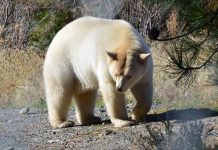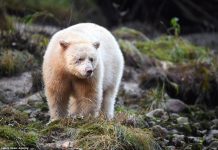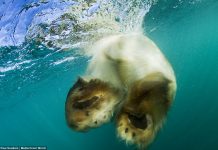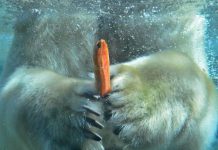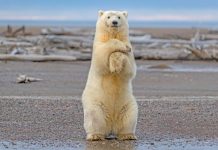Here are the most frequently asked questions about polar bears. Over the past few decades polar bears have become the subject of research for many scientists. While most scientists discuss polar bears in respect of global warming others seem to be interested in the biology and behavioral psychology of polar bears.
59How Do Polar Bears Eat?
Main Article: How Much Do Polar Bears Eat?
Adult polar bears start eating the seals blubber first because it gives them what they want that is fats. Young polar bears however consume meat because they need protein in their diet more than the fats.
58What Colors are Polar Bears?
Main Article: What Color are Polar Bears?
While polar bears seem white in color they are truly black within inside. The skin is absolutely black whereas the polar bear hairs are transparent. They just appear to be white.
57What Do Polar Bears Need to Survive?
Main Article: What Do Polar Bears Eat?
Polar bears for the most part of their lives need fats to survive in the frigid arctic habitat. They get fats from seals let alone ringed seals. They also need icy cold habitat where ice floes move over water. White bears hunt seals while standing on ice floes.
56Do Polar Bears Eat Seals?
Yes they definitely do! As a matter of fact seals are the most favorite diet of polar bears. For polar bears seals are the most nutritious meal and there can be no replacement ever for it. They are most likely to prey on ringed seals and less likely on bearded seals.
55Can Polar Bears Live in Warm Weather?/Can Polar Bears Survive in the Heat?
Main Article: How Do Polar Bears Adapt to their Environment?
Polar bears cannot live in warm weather for they may die in the heat within few hours. Even in the freezing temperature of the arctic polar bears get overheated when they run. That is one reason why polar bears silently approach their prey instead of charging it.
54Where Can you find Polar Bears?
You can find polar bears in five different countries that are adjacent to Arctic Circle. These countries are Denmark (Greenland), Norway, Canada (Svalbard), United States (Alaska), and Russia.
53Where Do you See Polar Bears in Alaska?
In Alaska polar bears are most likely to be seen in Barter Island especially during the ice-free summer months. There are communities that arrange trips for people to go and watch Arctic’s deadliest predator. Northern Alaska Tour Company (NATC) is one of them that design a Polar Bear Expedition each year.
52Do Polar Bears Live in the Antarctic?
No! Polar bears do not live in the Antarctic. Antarctic is the place of penguins which lies at the South Pole whereas polar bears live in the Northern Hemisphere—both are opposite ends of the pole.
51Why Don’t Polar Bears Live in the Antarctic?
Polar bears have never lived in the Antarctic probably because they have evolved to occupy a specialized ecological niche in the arctic. Besides, they have evolved from brown bears that also live in Alaska. Hence there is no chance that polar bears would ever find their way to the Antarctic.
50Why Don’t Polar Bears Feet get Freeze?
Polar bears feet do not get freeze even when the temperature drops down to negative 50 degree centigrade. They are covered with dense hairs which serve as insulators and prevent the feet from freezing.
49How Big is the Biggest Polar Bear?
The biggest polar bear weighed as much as 1,002 kg (2,209 lb) and it stood 3.39 m (11 ft 1 in) on its rear legs. The shoulder height measured at 122 to 160 cm (4 ft 0 in to 5 ft 3 in). The specimen shot in the northwestern Alaska in 1960. The biggest polar bear was a male.
48What Do Polar Bears Do?
Polar bears hunt for seals in the early winter, smell their mating partner during breeding season, enters into dormancy in early spring, and play-fight.
47Habitat of Polar Bear and Penguin?
The polar bear’s habitat is sea ice and water. The bear spends most of her time in swimming. Penguins also share the same habitat characteristics in that they live in water as well as on the sea ice.
46Do Polar Bears live in the North Pole?
Yes, polar bears live in the North Pole. Arctic lies at the North Pole and so as polar bears.
45Do Polar Bears live in the South Pole?
No, polar bears do not live in the South Pole. Penguins live in the South Pole. Polar bears and penguins cannot meet for they inhabit the opposite ends of the pole.
44Can Polar Bears Climb?
Polar bears can climb up the hill or small mountains but they cannot climb up the trees. They climb in the warmer months when the primary prey (seals) is scarce. Polar bears mostly climb up the hill to search birds or birds’ eggs. Over the past recent years they have adapted to eating geese eggs.
43How Big Do Polar Bears Get?/How Tall Can a Polar Bear Get?
Polar bears are quite bulky in that they weigh as much as 700 – 800 kilograms. An adult polar bear might be equal to three average-sized Siberian tigers. They can reach the height of about 5 – 6 feet while standing on her hindlegs.
42How Do Polar Bears Survive?
Polar bears eat a lot of seals in early spring. The pregnant females prey on ringed seals as many as she possibly can for she becomes dormant in the next 3 – 4 months. During dormancy polar bears consume available fats which they stored earlier. That is how polar bears survive the fasting months of the arctic.
41Can Baby Polar Bears Swim?
Not exactly in a way adult bears swim but yes they probably can! However baby bears get too tired while swimming and as it turns out they mount on the mother’s back and enjoys the rest of the journey. Besides, mother bear rarely allows her cubs to swim longer than usual.
40Do Polar Bears Drink Sea Water?
Not really! Polar bears get water by eating seal blubber. They don’t need to drink sea water for their survival.
39Do Polar Bears Eat Meat?
Yes, in fact the polar bear is the most carnivorous of all bears. Ice bears rely almost entirely on meat for their consumption. They eat seals and whale carcasses all day long. Sometimes only sometimes they eat green matter.
38How Many Polar Bears are Left?
While the exact count of polar bears population is not known the estimated global numbers are thought to be around 21,000 – 25,000 bears. These figures do not reflect on the polar bears inhabiting Russia. Thus the numbers are believed to be understated. Scientists maintain that there might be as many as 40,000 polar bears living in the world.
37Do Polar Bears Eat other Polar Bears?
Yes, polar bears do eat other polar bears but only sometimes. This is known as cannibalism in which the animal eats her own kind. Male polar bears often kill and (sometimes) eat polar bear cubs when they are extremely hungry.
36How Long does a Polar Bear Feed its Young Milk?
Polar bear mother is highly devoted mother unlike most other land carnivores. She will milk her cubs for as long as 1.5 – 2.0 years. The young bear remains with their mother until they reach 2 years age.
35What Do Newborn Cubs Look Like?
A newborn cub is nearly the size of a squirrel. It hardly weighs one kilogram at birth. The polar bear cubs are born blind, hairless, and toothless. They grow very quickly and gain weight in the next few days.
34How often does a Polar Bear have Babies?
Polar bears birth interval is 3 years. This is because of the prolonged lactation period. The mother feeds her young for two years and a year later she is ready to mate again. The female bear gives birth to twins but three is also not uncommon.
33Where Do Polar Bears Sleep?
Polar bears make dens where they can sleep and relax. They make dens on the ice floes as well as on land. Polar bears find best location to make dens—a place where the density of snow is the greatest to cover the den. The female bears enter into deep sleep (sort of hibernation) in dens. The dens are also called maternity dens because the mother raises her cubs inside the den.
32How Polar Bears are affected by Global Warming?
Over the last hundred years the global surface temperature has increased by 1.6 degree centigrade. This causes the Arctic sea ice to melt quickly than ever. The sea ice is the essential characteristic of a polar bear’s habitat. As it turns out the global climate change has rendered many of the white bears redundant.
31How aggressive is a Polar Bear?
Polar bears are quite aggressive but they are not as aggressive as they’re sometimes portrayed. Only a hungry polar bear is likely to attack humans that live within the bear’s territory otherwise they avoid fighting or getting in confrontations with humans. Nonetheless, during ice-free season polar bears may look at humans as a potential food source.
30What are the Threats to the Polar Bears?
Polar bears are not only facing habitat loss but they are also hunted in large numbers every year. The indigenous people are allowed to kill 50 – 60 polar bears each year because their living depends on it. Except in the United States, no serious protection is given and polar bears are quite threatened in much of their range.
29What is a Polar Bear’s Diet?
Polar bear’s primary diet consists of ringed seals and bearded seals whereas harp seals, whale carcasses, walruses, birds, and geese eggs make up the secondary diet of a bear.
28How Many Polar Bears are Killed Every Year?
Researchers estimate that every year around 50 – 60 polar bears are shot. Not only do the indigenous people but also the professional hunters illegally kill polar bears.
27Why is it Important to Save the Polar Bear?
Polar bears are apex predators of the Arctic’s ecological niche. They sit at the top of the food chain throughout the North Pole. Polar bear extinction means the population explosion of many marine mammals inhabiting the arctic.
26Why are the Polar Bears going Extinct?
First of all polar bears are not going extinct near future. Secondly possible causes of their endangerment are massive hunting, climate change, habitat loss, and starvation. Scientists blame global warming for the probable decline in polar bear population.
25What is the Habitat of a Polar Bear?
Polar bear’s habitat consists of sea ice including ice floes that move with the seasons as well as icy cold water. They prefer to make homes in the greatest density of snow so that the dens are completed covered and safe.
24Why Do Polar Bears Need the Ice?
Polar bears need the ice for two reasons: first they need ice to hunt seals secondly polar bears make dens on the ice floes. During summer months polar bears neither make dens on the snow nor do they hunt seals. Ice is probably the most essential characteristic of polar bear habitat.
23How Polar Bears have adapted to their Environment?
Over the past few years polar bears have adapted to living in the Arctic tundra and relying on animals other than seals. When seals are not available (during ice-free months) the bear resorts to eating birds, small land mammals, and whale or dolphin carcasses. It seems like polar bears are aware of their diet limitation and the fact that their survival is associated with the adaptability.
22Can Polar Bears Swim Well?
Polar bears are outstanding swimmers for they can swim for days without relaxing. Unlike any other bear the polar bear spends most of her time in water. That is why ice bear is also called marine mammal.
21What is the Adaptation of a Polar Bear?
The adaptation of a polar bear includes the bear sight, hearing, smell, teeth, and skull. The ability to camouflage and swimming are yet other adaptations that make polar bears stand out among the rest.
20How Much Do Polar Bears Eat a Day?
During spring season polar bears can eat up to 40 – 50 kilograms of meat every day. It occurs when the bear finds her primary prey that is ringed seals.
19Do Polar Bears like the Cold?
Polar bears do not only like the cold they also need it. They cannot survive the heat for the animal is protected by dense hair or fur.
18What is the Ecological Niche of the Polar Bear?
Polar bears always speak high of their strength and ability to prey just about anything in the arctic. They are the apex predators in that they dominate their ecological niche. Many arctic mammals fall prey to polar bears; from a vulnerable prey such as ringed seal to as large as walrus or beluga whale.
17Do Polar Bears have Thick Fur Coats?
Polar bears have extremely thick fur and the frequency of their furs is the highest when they reach adulthood. Ice bears are protected with two layers of fur: one is the external guard hair and the other is dense underfur. The guard hair measures 5 – 15 cm.
16Are Polar Bears Omnivores?
Polar bears are almost exclusively carnivores. They are the most carnivorous bear species. However polar bears do sometimes consume grass especially after mating. This can possibly make polar bears omnivorous but they are carnivorous omnivorous.
15How Long Can a Polar Bear Live up to?
Polar bears have a lifespan of about 15 – 25 years but they can live up to 35 years in captivity. The lifespan of a bear mainly depends on her habitat and diet. The greater is the habitat loss the lesser is the polar bear lifespan.
14How does a Polar Bear Camouflage?
Polar bears get easily lost in the snowy white background of the arctic ice. Seals do not have good eyesight and it becomes harder for them to spot white bears because the white color of the animal blends with the external environment. Besides, polar bears also disappear when someone takes shot from the sky. Biologists cannot spot polar bears when they view animal from above.
13What Color is a Polar Bear’s Skin and Fur?
The polar bears skin is absolutely black in color whereas the fur is crystal clear. Neither of these is white in color.
12What makes a Polar Bear White?
Polar bear’s fur makes the bear white. The bear’s fur lacks pigment. As a result the hairs are colorless. They do however reflect the snow white color of the ice. This indeed makes a polar bear white.
11Why Do Polar Bears have Black Skin?
The black color does not reflect the wavelength of light. It absorbs light. Polar bears have black skin color because it keeps the bear warm in the freezing arctic tundra.
10Why Do Polar Bears have Hollow Hair?
Polar bear hairs are hollow because it camouflages the animal and protects her from any potential threat. The hair reflects the white color of the snow which is why the bear appears white. During sunset however the polar bear looks yellowish orange for it reflects the sunlight.
9What is a Baby Polar Bear Called?
The baby polar bear is called a cub. The polar bear cub grows very quickly in the first couple of weeks.
8How Long does it take for a Polar Bear to be Fully Grown?
Polar bears are nearly the size of a squirrel at birth but they grow quickly within few weeks. However white bears attain their maximum weight and height at the age of 2 years. They become fully grown at 2 years age.
7How Do Polar Bears Protect themselves from Predators?
While polar bears do not appear to have any natural predators in the arctic they do nevertheless protect themselves against possible threats. Polar bears not only camouflage but they also go into their dens to prevent cubs from predators.
6Do Polar Bears Cover their Noses when they Hunt?
There is no scientific argument that explains why polar bears cover their noses (if at all) when they hunt. Polar bears never show behavior such as this. People might have observed bears covering their noses but scientists reject any such notion.
5Why Do Polar Bears live in the Arctic Circle?
Polar bears have occupied the arctic habitat since centuries. The bear has long adapted to living in the arctic ecosystem. They have evolved in the Northern Hemisphere and the entire North Pole provides the ideal setting for the polar bear’s habitat.
4Where Do You Find Polar Bears in Canada?
Polar bears are thought to occupy as much as 3.1 million square kilometers of area in Canada alone. The total population of the Canadian polar bears is estimated at 12,700. In Canada polar bears are found in James Bay, western and southern Hudson Bay, Newfoundland, and Southern Beaufort, and Labrador.
3Why Don’t Polar Bears Catch Seals in the summer?
Polar bears hunt seals while standing on the large chunks of ice. During summer the ice floes break forcing bears to rely on land animals. In this way polar bears resort to hunting some alternative prey instead of seals. They cannot eat seals in warmer months.
2Are Polar Bears Nocturnal?
Polar bear are crepuscular animals in that they remain active all day and night. The arctic tundra remains in darkness for as long as 3 – 4 months. If the bear adopts a diurnal lifestyle then she probably starves during these months. Similarly if she becomes nocturnal when the sun dominates the bear becomes helpless. Thus it is clear that polar bears must adapt to learn diurnal as well nocturnal lifestyle in the arctic tundra.
1What are some animals that live with polar bears?
Polar bears share their frozen habitat with many other animals such as ringed seals, bearded seals, arctic foxes, arctic wolves, walrus, muskox, arctic tern, arctic skua, arctic hare, Greenland shark, killer whale, beluga whale, narwhal, sea otter, snow geese, and puffins.
